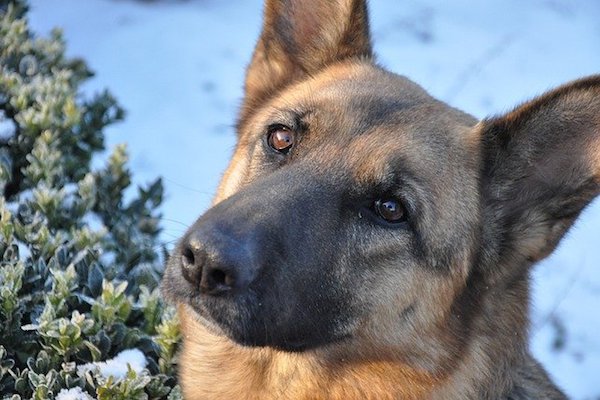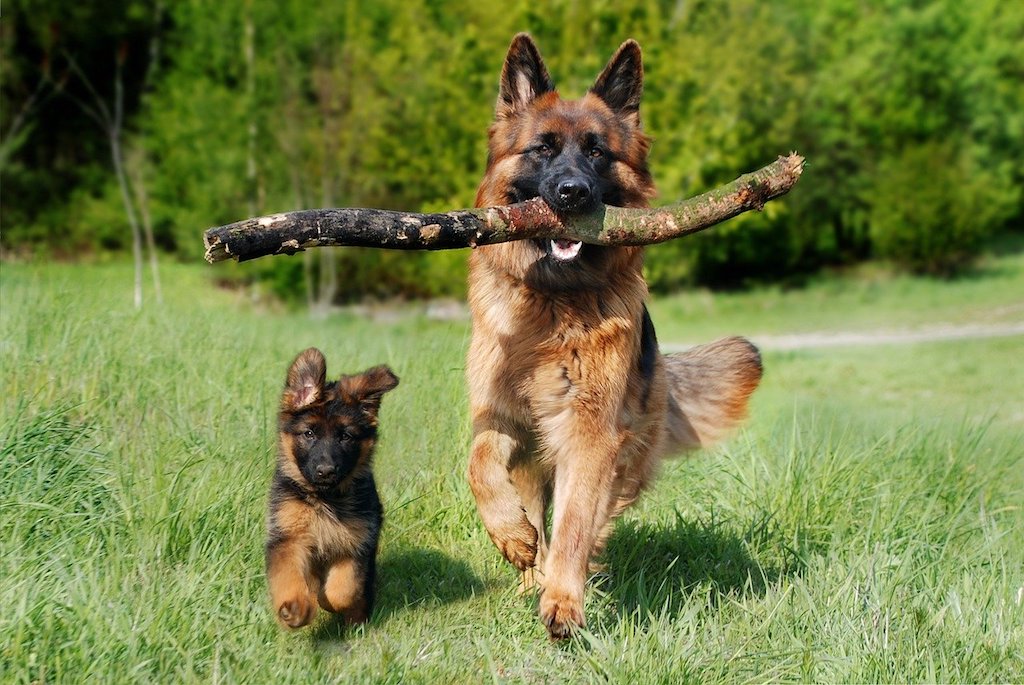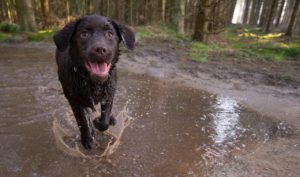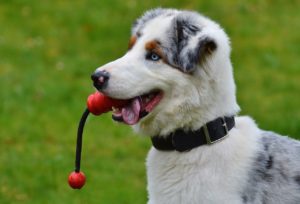Description
One of the most easily recognisable dog breeds, German Shepherds certainly are impressive in appearance. This large breed has a strong, lithe and muscular physique, but they are gentle and kind-natured dogs. They have a broad and thick chest, strong neck and powerful hindquarters. The legs are strong and athletic, and in proportion to the body. The back is level and muscular, and the tail is bushy and curves downward.
German Shepherds have an alert expression, with large ears which stand erect. The dark, almond-shaped eyes are kind and expressive. They have a broad head which tapers to long pointed muzzle.
The coat of a German Shepherd is thick and rough, consisting of a dense outer coat and a softer undercoat. It is normally of medium length, but occasionally longer-coated individuals may occur. German Shepherds can be black, tan, black and tan or gray in color.
This is an active and intelligent breed of dog which needs plenty of mental as well as physical stimulation. German Shepherds will thrive in a busy family environment, with lots of exercise and play. Bred as a working dog, this breed responds well to training and can excel at sports such as agility and tracking.

Common health problems
German Shepherds are generally healthy and athletic dogs, but like all pedigree breeds they are susceptible to certain health problems. If you are buying a German Shepherd puppy then a reputable breeder should have screened the parents for health conditions such as degenerative myelopathy and elbow and hip dysplasia.
Hip Dysplasia
Hip dysplasia is a hereditary condition which causes the hip joints to form improperly, leading to arthritis. It is unfortunately very common to see German Shepherds with weakness in the hindquarters, caused by hip dysplasia. If you are purchasing a German Shepherd puppy it is essential to check with the breeder that the parents have been screened for hip dysplasia. Hip dysplasia is a painful lifelong condition which can require long-term medication or expensive surgical treatment.
Elbow Dysplasia
Another hereditary condition, elbow dysplasia occurs when the elbow joint develops abnormally, causing painful arthritis. This causes forelimb lameness and limited movement of the elbows. The consequences are a painful and limited movement of the elbows and limping of the front legs. Surgical treatment may reduce the symptoms, but long-term medication may be required.
Degenerative Myelopathy
Degenerative myelopathy (DM) is a disease that affects the spinal cord. The white matter contained within the spinal cord starts to break down, or degenerate, resulting in weakness of the hind limbs. As the disease progresses the fore limbs may also be affected, and paralysis of the hind limbs can occur.
This condition normally occurs in dogs over eight years of age. The first signs of DM are subtle – the dog may wobble when standing still, have difficulty getting up from lying down or sitting, and lose its balance easily. Unfortunately there is no treatment available for this condition. They symptoms can be managed for some time with physical therapy and aids, but ultimately the severity of the condition normally leads to euthanasia.
Gastric Dilatation-Volvulus
Gastric Dilatation-Volvulus (GDV), also known as bloat, is a medical condition that normally affects large and giant breed dogs. When a GDV occurs, the stomach fills with gas or food, expands, and then rotates, trapping gas inside the stomach and cutting off the blood supply to vital organs. This is an incredibly painful and potentially fatal condition, and if medical attention is not sought immediately the stomach can rupture.
The most common sign that your dog is suffering from GDV include a bloated abdomen, unproductive retching, lethargy and heavy panting. The gums may also be pale and the dog may be salivating excessively. If you suspect that your dog may be suffering from bloat it is vital to take them immediately to the veterinary clinic, as catching this condition early enough will increase your dog’s chances of survival.

Personality traits
German Shepherds are smart and obedient dogs. They are very loyal, gentle, friendly and patient and can be very rewarding dogs to train. German Shepherds bond closely with their owners and can be quite protective, so it is important to socialize them well to help them relax when meeting new people.
Although a great choice for a family pet, these are big powerful dogs and should not be left unsupervised with children. They are renowned for chasing cats and don’t always make friends with other dogs easily, so are maybe not the best choice for a multi-pet household. This is a breed that likes to chew, so have plenty of chew toys available.
This is a very athletic breed, and German Shepherds require a lot of attention and play. They will not thrive if left alone for long periods and can quickly develop separation anxiety. However, the time and affection you put into this majestic breed will be rewarded tenfold with their loyal and eager-to-please nature!
Care
German Shepherd Dogs are generally quite easy to care for, but they do have some specific care needs to help prevent health problems. These energetic dogs require plenty of exercise, and they need plenty of mental stimulation to prevent behavioral problems from developing.
Grooming
German Shepherds have a dense double coat; this becomes thicker in the winter and the main shedding season is spring. A twice-weekly groom with a soft brush will be sufficient to remove loose hair and keep the skin healthy. During shedding season a grooming mitt is useful to remove the finer hairs. Luckily, the thick coat resists dirt and a bath once a month should be sufficient – any more than this will strip the healthy oils from the coat.
It is essential to keep your German Shepherd’s nails trimmed to prevent breakages and snagging. Check the ears regularly for signs of infection. Brushing the teeth daily will help to maintain good dental health and prevent dental disease.
Feeding
German Shepherd dogs do not have any special dietary requirements and will normally thrive on a good quality complete diet. Weigh the food to accurately monitor your dog’s food intake. Avoid adding in extra treats such as titbits and table scraps. German Shepherds have a sensitive digestive system and some foods can cause stomach upsets.
To prevent bloating, split your German Shepherd’s daily food allowance into at least two meals per day. Extend the time it takes to eat each meal by using slow feeder bowls. Avoid exercising your German Shepherd immediately after feeding.
Training
German Shepherd Dogs are intelligent and eager to please – this is a dog which was bred to work! They are fun and rewarding dogs to train, easily motivated by food and praise. They respond well to positive training methods with clear and concise instructions.
Putting the effort into training your German Shepherd puppy will help to build a good foundation for life. Socialization is vital for this breed, as they can become overprotective of their human family and wary of strangers. Taking the time to introduce your German Shepherd to as many different people, dogs and situations as possible will reap huge benefits later in life.
Exercise
German Shepherd dogs are full of energy and also need huge amounts of mental stimulation. Their daily walk should be at least one hour long and include a combination of walking and running. Walking will help to build and maintain muscle, while running allows your German Shepherd to release pent-up energy. Take care in warmer weather, as your German Shepherd will struggle to stay cool if exercised in the heat of the day.
Ideally, German Shepherds should have the opportunity to roam free in an enclosed garden. Daily play time with the family will help to give plenty of mental stimulation as well as physical exercise. This is a dog which wants to be part of the family, so expect to include him on family outings such as trail walking and trips to the park.

History
Developed from shepherd and farm dogs, the German Shepherd was first introduced in Germany in 1899. German cavalry officer Captain Max von Stephanitz came across a dog that exhibited excellent herding skills and bred him with the intention of creating the perfect working dog. A stringent breeding programme quickly developed the breed as we know it today.
Interest in the German Shepherd dog began rising in the early 1900s and the breed was recognized by the American Kennel Club in 1908. During World Wars I and II, the breed was referred to as the shepherd dog or the Alsatian – in fact, in some regions the German Shepherd is still referred to as an Alsatian to this day.
Today, as well as being popular family pets, German Shepherds are widely used as working and service dogs. They are the dog of choice for the military and police forces. Their gentle, loyal and intelligent nature makes them excellent therapy dogs and assistance dogs. They are very talented at search and rescue, and as sniffer dogs for drug and explosive detection.
Interesting facts
- German Shepherds are famous for their search and rescue efforts. After the 9/11 terrorist attacks they crawled though the ruins of the World Trade Center looking for survivors.
- A German Shepherd Dog named Rin Tin Tin was rescued from a WWI battlefield and starred in many films in the 1920s.
- The first guide dog was a German Shepherd dog called Buddy. Trained in Switzerland, Buddy helped his owner Morris Frank navigate the streets of New York City from 1928 onwards.










